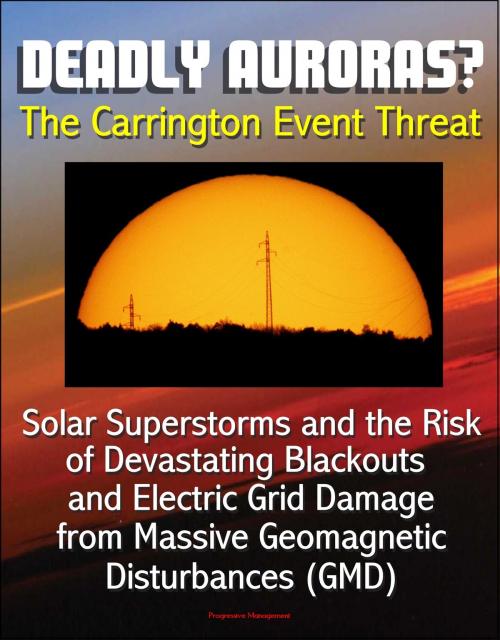Deadly Auroras? The Carrington Event Threat: Solar Superstorms and the Risk of Devastating Blackouts and Electric Grid Damage from Massive Geomagnetic Disturbances (GMD)
Nonfiction, Science & Nature, Technology, Electricity, Science, Physics, Astrophysics & Space Science| Author: | Progressive Management | ISBN: | 9781301829668 |
| Publisher: | Progressive Management | Publication: | August 4, 2013 |
| Imprint: | Smashwords Edition | Language: | English |
| Author: | Progressive Management |
| ISBN: | 9781301829668 |
| Publisher: | Progressive Management |
| Publication: | August 4, 2013 |
| Imprint: | Smashwords Edition |
| Language: | English |
This comprehensive and up-to-date ebook presents the complex story behind the threat posed by massive solar storms to the electric grid. There is growing concern that a repeat of the colossal "Carrington-event" storm of 1859, or even the lesser 1921 solar storm, could wreak unprecedented havoc on America's electric power system, potentially causing prolonged blackouts. In a worst-case scenario, some researchers believe that a giant solar storm could catastrophically damage hundreds of huge high-voltage transformers critical to the grid; since the replacement of these components could take years, unimaginable consequences are possible. Here we have compiled dozens of official documents and reports that explain the threat and explore possible measures to limit the risk. Contents: Part 1: Overview of the Threat * Part 2: Federal Energy Regulatory Commission (FERC) Material * Part 3: U.S. Congressional Hearings * Part 4: Department of Homeland Security Evaluation * Part 5: Federal Emergency Management Agency (FEMA) Material * Part 6: Secure Grid '11: Electrical Grid Crisis Tabletop Exercise * Part 7: Large Power Transformer Study Report * Part 8: Space Weather * Part 9: The Sun, the Earth, and Near-Earth Space: A Guide.
The nation's power grid is vulnerable to the effects of an electromagnetic pulse (EMP), a sudden burst of electromagnetic radiation resulting from a natural or man-made event. EMP events occur with little or no warning and can have catastrophic effects, including causing outages to major portions of the U.S. power grid possibly lasting for months or longer. Naturally occurring EMPs are produced as part of the normal cyclical activity of the sun while man-made EMPs, including Intentional Electromagnetic Interference (IEMI) devices and High Altitude Electromagnetic Pulse (HEMP), are produced by devices designed specifically to disrupt or destroy electronic equipment or by the detonation of a nuclear device high above the earth's atmosphere. EMP threats have the potential to cause wide scale long-term losses with economic costs to the United States that vary with the magnitude of the event. The cost of damage from the most extreme solar event has been estimated at $1 to $2 trillion with a recovery time of four to ten years, while the average yearly cost of installing equipment to mitigate an EMP event is estimated at less than 20 cents per year for the average residential customer. Naturally occurring EMP events resulting from magnetic storms that flare on the surface of the sun are inevitable. Although we do not know when the next significant solar event will occur, we do know that the geomagnetic storms they produce have occurred at varying intensities throughout history. We are currently entering an interval of increased solar activity and are likely to encounter an increasing number of geomagnetic events on earth. In 1989, an unexpected geomagnetic storm triggered an event on the Hydro-Quebec power system that resulted in its complete collapse within 92 seconds, leaving six million customers without power. This same storm triggered hundreds of incidents across the United States including destroying a major transformer at an east coast nuclear generating station. Major geomagnetic storms, such as those that occurred in 1859 and 1921, are rare and occur approximately once every one hundred years. Storms of this type are global events that can last for days and will likely have an effect on electrical networks worldwide. Should a storm of this magnitude strike today, it could interrupt power to as many as 130 million people in the United States alone, requiring several years to recover. Mitigation technologies to protect the power grid against such a costly EMP event can be developed, and in some cases do exist. - Federal Energy Regulatory Commission (FERC)
This comprehensive and up-to-date ebook presents the complex story behind the threat posed by massive solar storms to the electric grid. There is growing concern that a repeat of the colossal "Carrington-event" storm of 1859, or even the lesser 1921 solar storm, could wreak unprecedented havoc on America's electric power system, potentially causing prolonged blackouts. In a worst-case scenario, some researchers believe that a giant solar storm could catastrophically damage hundreds of huge high-voltage transformers critical to the grid; since the replacement of these components could take years, unimaginable consequences are possible. Here we have compiled dozens of official documents and reports that explain the threat and explore possible measures to limit the risk. Contents: Part 1: Overview of the Threat * Part 2: Federal Energy Regulatory Commission (FERC) Material * Part 3: U.S. Congressional Hearings * Part 4: Department of Homeland Security Evaluation * Part 5: Federal Emergency Management Agency (FEMA) Material * Part 6: Secure Grid '11: Electrical Grid Crisis Tabletop Exercise * Part 7: Large Power Transformer Study Report * Part 8: Space Weather * Part 9: The Sun, the Earth, and Near-Earth Space: A Guide.
The nation's power grid is vulnerable to the effects of an electromagnetic pulse (EMP), a sudden burst of electromagnetic radiation resulting from a natural or man-made event. EMP events occur with little or no warning and can have catastrophic effects, including causing outages to major portions of the U.S. power grid possibly lasting for months or longer. Naturally occurring EMPs are produced as part of the normal cyclical activity of the sun while man-made EMPs, including Intentional Electromagnetic Interference (IEMI) devices and High Altitude Electromagnetic Pulse (HEMP), are produced by devices designed specifically to disrupt or destroy electronic equipment or by the detonation of a nuclear device high above the earth's atmosphere. EMP threats have the potential to cause wide scale long-term losses with economic costs to the United States that vary with the magnitude of the event. The cost of damage from the most extreme solar event has been estimated at $1 to $2 trillion with a recovery time of four to ten years, while the average yearly cost of installing equipment to mitigate an EMP event is estimated at less than 20 cents per year for the average residential customer. Naturally occurring EMP events resulting from magnetic storms that flare on the surface of the sun are inevitable. Although we do not know when the next significant solar event will occur, we do know that the geomagnetic storms they produce have occurred at varying intensities throughout history. We are currently entering an interval of increased solar activity and are likely to encounter an increasing number of geomagnetic events on earth. In 1989, an unexpected geomagnetic storm triggered an event on the Hydro-Quebec power system that resulted in its complete collapse within 92 seconds, leaving six million customers without power. This same storm triggered hundreds of incidents across the United States including destroying a major transformer at an east coast nuclear generating station. Major geomagnetic storms, such as those that occurred in 1859 and 1921, are rare and occur approximately once every one hundred years. Storms of this type are global events that can last for days and will likely have an effect on electrical networks worldwide. Should a storm of this magnitude strike today, it could interrupt power to as many as 130 million people in the United States alone, requiring several years to recover. Mitigation technologies to protect the power grid against such a costly EMP event can be developed, and in some cases do exist. - Federal Energy Regulatory Commission (FERC)















